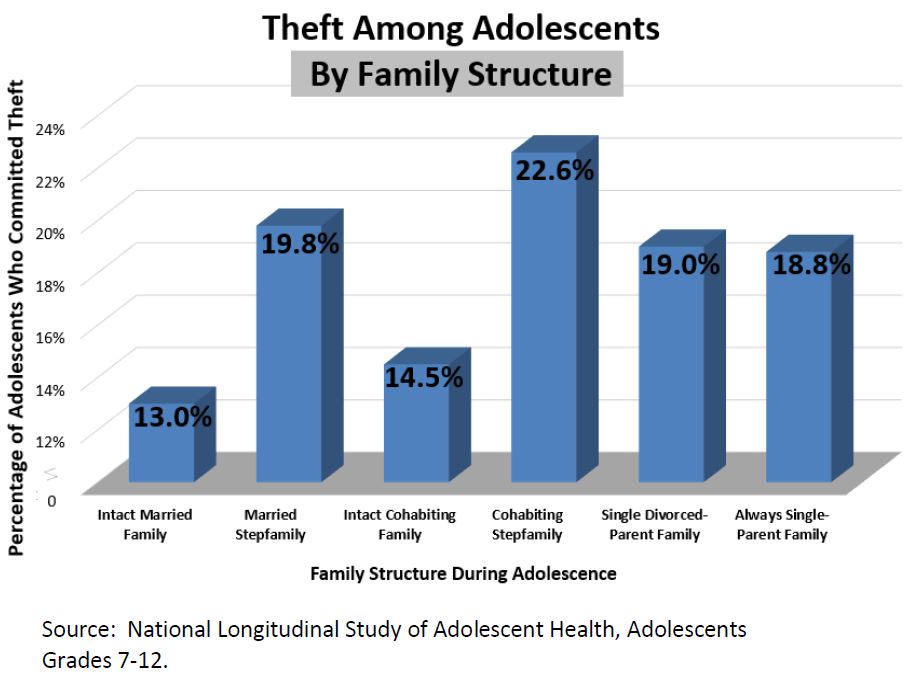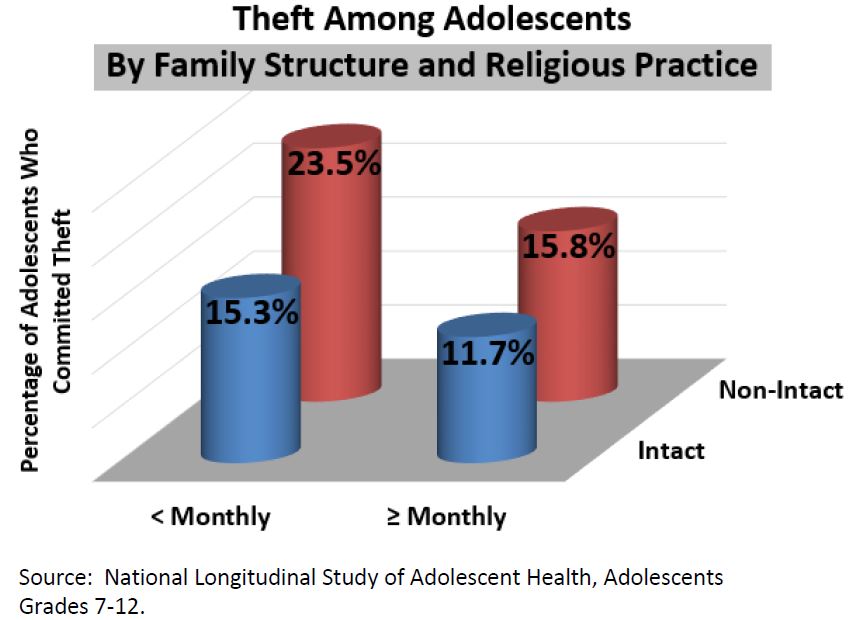Click Here to download “Theft Among Adolescents by Family Structure and Religious Practice”
Theft Among Adolescents by Family Structure and Religious Practice
Family Structure: According to a confidential survey conducted as part of the National Longitudinal Study of Adolescent Health, 13 percent of children who lived in intact married families admitted to having stolen at least $50 worth of goods. By comparison, 18.8 percent of children whose parents never married, 19 percent of those whose parents were divorced, 19.8 percent of those living with a step-parent, 14.5 percent of those living with cohabiting biological parents, and 22.6 percent of those living in cohabiting stepfamilies had stolen at least $50 worth. Religious Practice: The National Longitudinal Study of Adolescent Health showed that 12.7 percent of students in Grades 7-12 who attended religious services at least weekly admitted to having stolen at least $50 worth of goods. By comparison, 18.7 percent of those who never worshipped, 14.4 percent of those who worshipped one to three times a month, and 17.6 percent of those who attended religious services less than once a month had committed similar thefts.
Religious Practice: The National Longitudinal Study of Adolescent Health showed that 12.7 percent of students in Grades 7-12 who attended religious services at least weekly admitted to having stolen at least $50 worth of goods. By comparison, 18.7 percent of those who never worshipped, 14.4 percent of those who worshipped one to three times a month, and 17.6 percent of those who attended religious services less than once a month had committed similar thefts.
 Family Structure and Religious Practice Combined: Only 11.7 percent of adolescents who lived with both biological parents and worshipped at least monthly had ever stolen at least $50 worth of goods. By contrast, 23.5 percent of adolescents who worshipped less than monthly and came from single-parent or reconstituted families had stolen similar amounts. In between were those in non-intact families who worshipped at least monthly (15.8 percent) and those who lived with both biological parents and worshipped less than monthly (15.3 percent).
Family Structure and Religious Practice Combined: Only 11.7 percent of adolescents who lived with both biological parents and worshipped at least monthly had ever stolen at least $50 worth of goods. By contrast, 23.5 percent of adolescents who worshipped less than monthly and came from single-parent or reconstituted families had stolen similar amounts. In between were those in non-intact families who worshipped at least monthly (15.8 percent) and those who lived with both biological parents and worshipped less than monthly (15.3 percent).
 Related Insights from Other Studies: Though little additional research has been done that correlates these three measures, what studies exist corroborate the direction of these findings. Wendy Manning of Bowling Green State University and Kathleen Lamb of the University of Wisconsin reported that adolescents who were more religious were less likely to be delinquent, as were adolescents who lived with their married parents.[1]
Mark Regnerus of the University of Texas at Austin and Glen Elder of the University of North Carolina at Chapel Hill found that adolescents who attended religious services at least weekly and adolescents who are satisfied with their family were less likely to engage in delinquent behavior.[2]
In another study, Regnerus reported that family satisfaction and religiosity were strong protective factors against adolescent delinquency, although religiosity affected adolescent boys only indirectly through higher levels of family satisfaction.[3]
The available evidence indicates that the dual influence of religious attendance and an intact married family prove to be effective in reducing theft by adolescents.
[1] Wendy D. Manning and Kathleen A. Lamb, “Adolescent Well-Being in Cohabiting, Married, and Single-Parent Families,” Journal of Marriage and Family, vol. 65 (2003): 876-893. The delinquency measures included stealing something worth more than $50 and stealing something worth less than $50.
[2] Mark D. Regnerus and Glen H. Elder, “Religion and Vulnerability among Low-Risk Adolescents,” Social Science Research, vol. 32 (2003): 633-658. The delinquency measures included stealing something worth more than $50 and stealing something worth less than $50.
[3] Mark D. Regnerus, “Linked Lives, Faith, and Behavior: Intergenerational Religious Influence on Adolescent Delinquency,” Journal for the Scientific Study of Religion, vol. 42 (2003): 189-203. The delinquency measures included stealing something worth more than $50 and stealing something worth less than $50.
]]>
Related Insights from Other Studies: Though little additional research has been done that correlates these three measures, what studies exist corroborate the direction of these findings. Wendy Manning of Bowling Green State University and Kathleen Lamb of the University of Wisconsin reported that adolescents who were more religious were less likely to be delinquent, as were adolescents who lived with their married parents.[1]
Mark Regnerus of the University of Texas at Austin and Glen Elder of the University of North Carolina at Chapel Hill found that adolescents who attended religious services at least weekly and adolescents who are satisfied with their family were less likely to engage in delinquent behavior.[2]
In another study, Regnerus reported that family satisfaction and religiosity were strong protective factors against adolescent delinquency, although religiosity affected adolescent boys only indirectly through higher levels of family satisfaction.[3]
The available evidence indicates that the dual influence of religious attendance and an intact married family prove to be effective in reducing theft by adolescents.
[1] Wendy D. Manning and Kathleen A. Lamb, “Adolescent Well-Being in Cohabiting, Married, and Single-Parent Families,” Journal of Marriage and Family, vol. 65 (2003): 876-893. The delinquency measures included stealing something worth more than $50 and stealing something worth less than $50.
[2] Mark D. Regnerus and Glen H. Elder, “Religion and Vulnerability among Low-Risk Adolescents,” Social Science Research, vol. 32 (2003): 633-658. The delinquency measures included stealing something worth more than $50 and stealing something worth less than $50.
[3] Mark D. Regnerus, “Linked Lives, Faith, and Behavior: Intergenerational Religious Influence on Adolescent Delinquency,” Journal for the Scientific Study of Religion, vol. 42 (2003): 189-203. The delinquency measures included stealing something worth more than $50 and stealing something worth less than $50.
]]>
